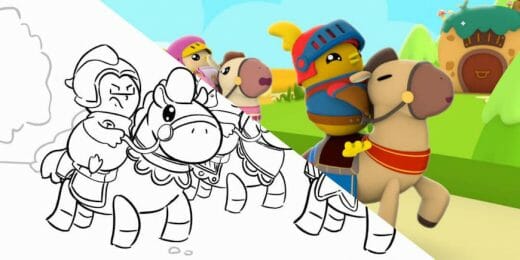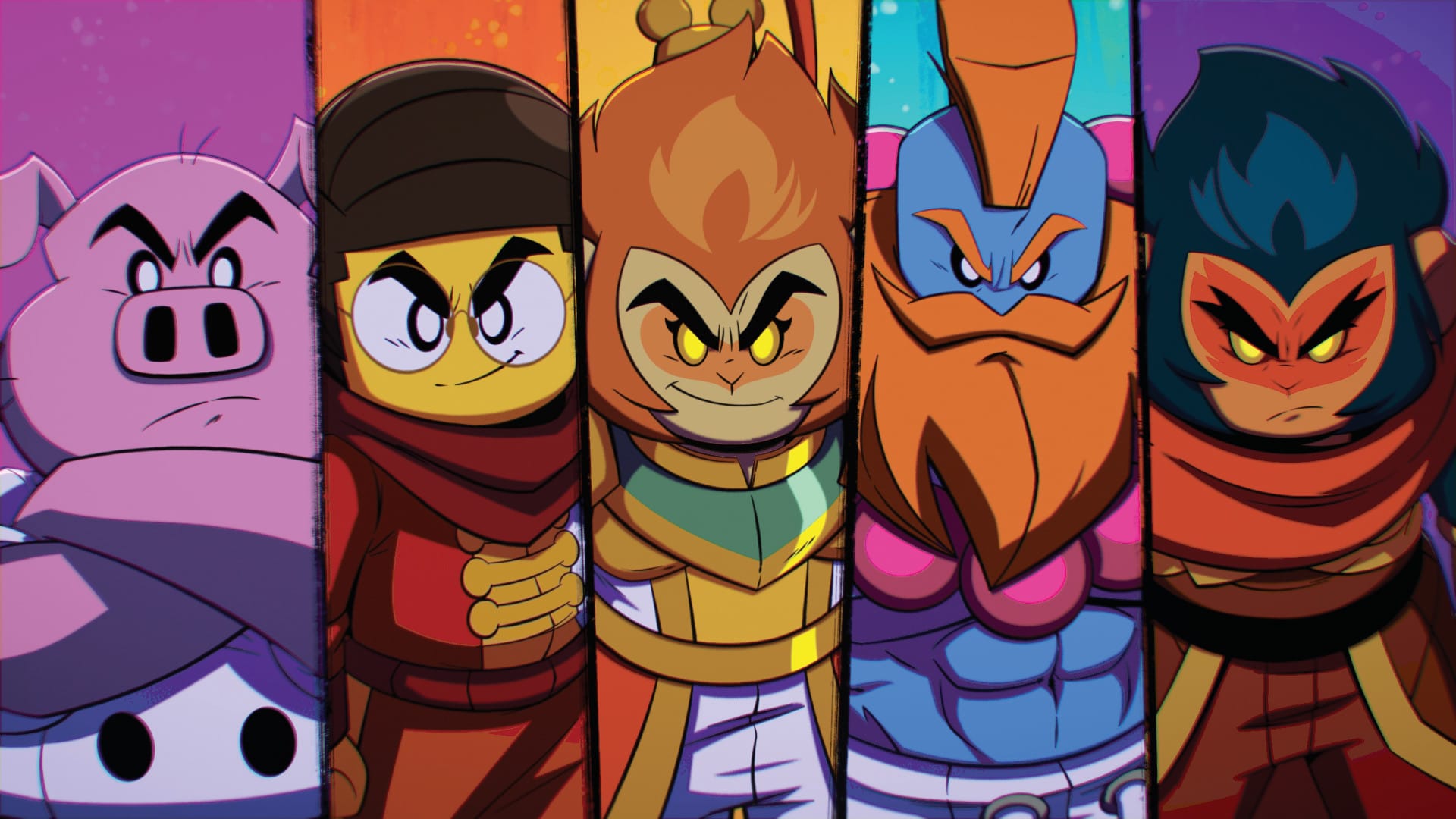
Building on inspiration from Journey to the West, LEGO Monkie Kid is a tale which centres around a noodle delivery boy who gains mystical powers after chancing upon an item that belonged to the original Monkey King. A tale of destiny and friendship, this animated series brings together well-loved LEGO character designs with breathtaking 2D animation and expansive world building.
Put in charge of bringing this story to life is Flying Bark Productions, an animation studio based across Sydney and L.A. The studio was tasked by the team at LEGO to put this popular Monkie Kid toy franchise — their first line of toys adapted from classical Chinese literature — onto the small screen. We were lucky enough to speak with Sarah Harper (Flying Bark’s Creative Director) about the production. Sarah offers up fascinating insights on how to turn toy miniatures into animated characters without losing their original LEGO essence and the thorough research that went into the series.
As Sarah explains in our interview, the collaboration was an international effort that involved animation studios and departments from LEGO from across the globe. She also shares key insights into this process, and how Toon Boom Harmony fit into the series’ animation pipeline.
Please introduce LEGO Monkie Kid in your own words.
Sarah: LEGO Monkie Kid is a hand drawn, frame-by-frame, 2D animated action adventure series. The series is a spiritual sequel to the 7th century Chinese classic Journey to the West. Set hundreds of years after the original journey, Monkie Kid, a noodle delivery guy, discovers the staff belonging to the legendary Monkey King. This mysteriously grants Monkie Kid the powers of the great sage and forever changes the path of his destiny.
Monkie Kid’s life is thrown into exciting — and at times, traumatic — chaos, forced to confront villains from Monkey King’s past. And through Sun Wukong’s tutelage, begins to master his newfound power and uncover the truth of his mysterious origin.
Who were some of the key team members who worked with you on the show?
Sarah: Monkie Kid was a massive group effort, so there is no way I could list everyone without forgetting people! It was a huge collaboration between our Flying Bark Productions’ Sydney studio and LEGO’s teams out of Denmark, China and LA.
I oversaw the entire production from scripting to post as series director, with David Breen acting as script producer (and later, co-story editor). Christian Barkel was our amazing animation director for series 1-3 (and as of series 4, series director), cultivating the animation style with the animation team out of Sydney and collaborating with our long time friends at Digitoonz, who provided the ink-and-paint for most of our 2D productions. They’re amazing! And the series was largely produced remotely as a result of Covid.
The design for the series was largely driven by Josh Reh (art director). His team interpreted every script to create gorgeous sets that were inspired by everything from LEGO product designs — such as the Celestial Realm, Pigsy’s Noodle Shop, and a few others — to locations from the original novel or various adaptations. So you have Josh and his team to thank for the beautiful world of Lego Monkie Kid!
Glossing over a whole bunch of really important and talented artists and production folk here, but in addition to the animation, we also had the opportunity to collaborate with the amazing pre and post-production teams out of NYAV Post (USA voice recording), Tian Ying Media (Shanghai voice recording), Cutting Edge (post-production services), Frank Sound Design and The DA’s Office, the composers who provided the awesome original soundtrack for the series!
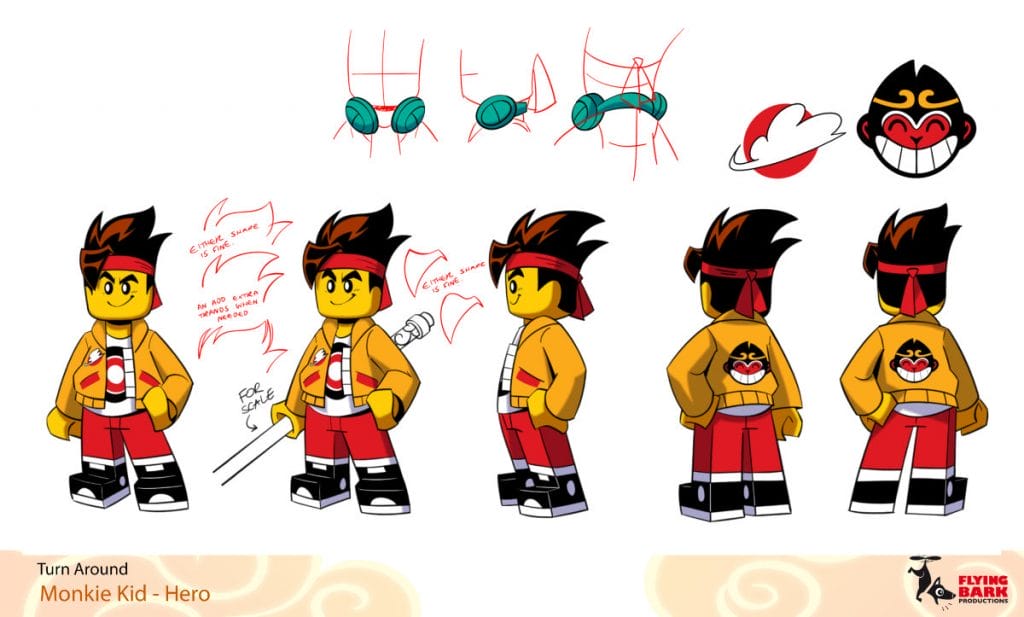
What was the process of designing each character like?
Sarah: Being a LEGO show, many of the characters and vehicles are created initially by LEGO, then sent to us for our 2D interpretation! For those elements, LEGO would send us their minifigure designs. Our character designers Donavan Foo and Christine Wilson would then translate that design to the house style we developed at Flying Bark for the show.
Although each character shares similar proportions and facial details, there are plenty of design elements that are unique to each character. For example, Macaque and Monkey King share a similar facial design, but their face markings and eyebrows have unique differences. And, of course, costume design choices and colors are considerations when designing each character. All that to say, we don’t have a specific ‘template’ that our artists use, but we do have a style guide that generally ensures that each character feels like it fits in the same universe; that the hand shapes are correct, that the eyes are the right size proportional to the head, and things like that.
The style is generally quite volumetric too. So each character has clear construction guides to ensure that the shapes are clear and the characters aren’t feeling too flat. Unless, of course, the moment calls for it!
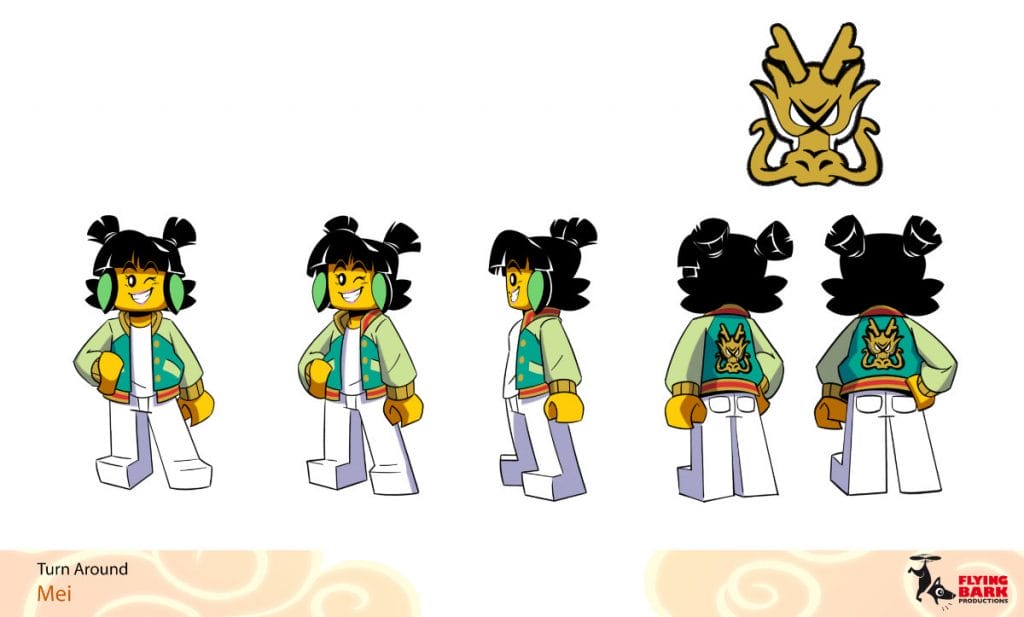
What are some unique challenges when it comes to designing and animating LEGO characters?
Sarah: Agreeing that they still look like LEGO? Before we began production on the series, Christian and I were both super-excited to push the style of the show. LEGO animations are probably best known for their CG look and toyetic feel, so we knew that creating something different would be a challenge. But LEGO were all for it, and wanted us to: “Push them out of their comfort zone.” Famous last words perhaps!
The show is very exaggerated and pushes the model of the minifigure more so than their CG production do. So I think it was a bit of a shock for the team over there at first! Over time I think the team at LEGO came to love the way we had interpreted the minifigure for 2D animation.
Monkie Kid never had an extensive development period, really. At least on the Flying Bark’s side. After the initial test we did back in December 2018, we essentially went into production a few months later. So as much as I love those early episodes — and the first season generally — there were a lot of growing pains as we figured out the style. The character models went through a LOT of growth over that first season, even within the first 2 episodes. How volumetric did we want to go? How did the anatomy need to compare to literal anatomy and how do we get c-snap hands to convey gestures when they don’t have fingers? That was a challenge we were already familiar with after our work on Nickelodeon’s The Rise of the Teenage Mutant Ninja Turtles!
Over time, we figured out what worked for the team and ended up falling into a style that was a combination of Don and Christine’s designs, refined by Christian and the animation supervisors’ direction. I love where the style ended up; something that felt expressive and 2D while still retaining a lot of that recognizable LEGO DNA. I think we landed on something everyone was happy with, so much so that Donavan provided the illustrations on the side of the boxes for the season 4 products. That was super cool!
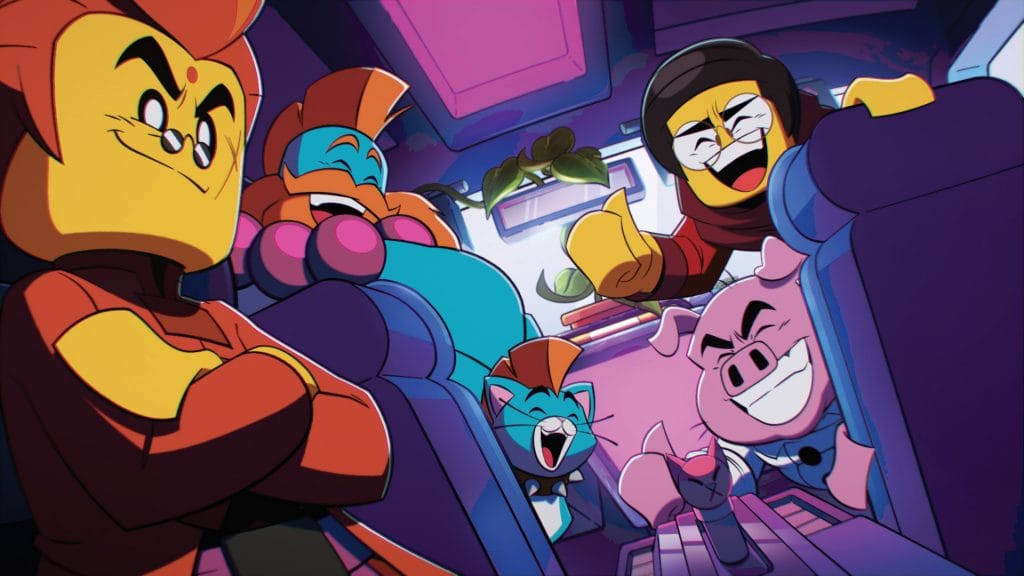
What tools or techniques were used on the VFX in the show?
Sarah: Monkie Kids’ exaggerated and expressive character animation needed to be complimented by an even more bombastic FX style. Like with the character animation the process is primarily the arduous process task of painstakingly animating frame by frame. But with such a large FX order, the more atmospheric elements like dust, clouds or magical runes are often deformed still-images from our background or design teams. Curve, free form, and weighted deformers allowed us to have a lot more explosions than we otherwise might have. Though, we still did have a lot!
With Harmony we’re able to composite as we move through our animation pipeline as well. The compositing capabilities of the software allowed our artists to add those finishing touches to the artwork that they felt worked for their shots, such as applying glows, motion blur, colour grading, and all that. They understand the intent and timing of the shot better than anyone. And as the other elements such as; colour backgrounds, final character animation are completed we continue to adjust those glows, blurs etc. till the final image.
How did Toon Boom software help you achieve LEGO Monkie Kid’s visual style?
Sarah: Toon Boom Harmony is crazy powerful and could pretty much achieve anything we could imagine. We created a lot of different compositing treatments, brushes and effects in the software, especially with season 4 implementing a lot of sketchy, inky effects that Tessa Bright (season 4 animation director) and Brent Skinner (technical animation supervisor) developed.
What was the approach to creating the background environments, like the celestial realm?
Sarah: It varied from set to set. Some were inspired by locations from the original novel, others from the various film and television adaptations or from distinct locations from across China. When we were initially developing the look for the series, we spent a lot of time researching traditional Chinese architecture. Although the series is set in a non-specified future China, the original novel is set in the Tang Dynasty, with many characters and environments from the period appearing throughout the series. So these were details we wanted to get right!
There was so much to consider, such as using the right roof tile colours or building style designs for the time, right down to whether or not a certain dye existed in that time period or if a type of vegetables existed in the region! We considered every single detail when designing our characters and environments. The team worked alongside our translators and cultural consultants Steven Liu and Chapman Chan (also our Mandarin Director) to ensure we had the details correct.
The Monkie Kid background style is fairly distinct, inspired by a lot of blocky lego shapes with miniaturization at the forefront. We wanted the sets to feel rich with character and detail, but still feel small and Lego inspired, so you’ll notice that most of the details and props are quite chunky.
How was your experience working in collaboration with an iconic brand like LEGO?
Sarah: It was a lot more collaborative than I had initially expected! It was something we were a little nervous about at first because LEGO has such an established look, brand and style of storytelling that felt so different from our usual brand of boisterous chaos. But I think we were really lucky that there were a lot of like-minded people at LEGO who wanted to set out to make something really special; just like we did. To push the brand and make something fresh and different.
Obviously when you’re working with such an established brand, there are always going to be disagreements, but largely they felt mostly contained to the character designs and the interpretation of the products. If you have any LEGO nearby, go grab it and just look at how shockingly detailed those figures are. Beautifully detailed of course, but it was a balance of finding that middle ground that the team in Denmark were happy with, but also wouldn’t totally destroy our animation team or limit how much our characters could move.
LEGO were largely hands-off when it came to the animation. The various EP’s that worked with us across the series (Robert Fewkes, Villads Spansberg, Thomas Sorensen and Courtney Arumugam) largely trusted our gut instincts and gave us a lot of room to move and breathe, bumping us back on the tracks if we veered too far into territory that made LEGO feel was too off-brand. They were all eager to push the boundaries of the brand a bit so I think that we were super-lucky for that and could trust in their experience too. Many of them have been at LEGO for a long time.
Tell us about a day in the life at Flying Bark Animation.
Sarah: It usually starts with waiting for the elevator to come down. It moves at a racing 2 meters per hour! Recently, Flying Bark relocated to a larger studio in Sydney. Previously we had been split across two studios, with the CG teams working in one and the 2D team working in another. Not for any reason other than our combined studio was simply too big to fit under one roof. Which almost happened over night as the 2D team began to grow bigger and bigger.
The studio has always had a really fun community vibe. Covid threw a bit of a spanner in the works, with a lot of the team required to work from home for the majority of the Monkie Kid production. But everyone still found a way to stay connected. To the point where it didn’t feel that different to being in-studio! Although we spend most of the day sitting in rows of desks in almost complete focused silence, ‘cause animation is a boring spectator sport!
When people come to visit the studio, they tend to remark on how you wouldn’t know anyone was in there on account of how quiet everyone was! It’s a funny contrast though when lunch time hits, or we have an episode screening, because the whole studio will just come alive and be completely unrecognizable. Episode screenings are probably my favourite. All the joking, the heckling; it’s all good vibes because everyone loves what they’re making. We’re inspired by and support each other. It’s super nice.
Any parting advice for aspiring animators?
Sarah: So much of my journey in animation was just taking a leap and hoping it paid off! I guess that’s kind of a takeaway in a weird way. If something feels scary or unknown, give it a crack anyway. ‘Cause, who knows? It could lead you to something amazing!
Surround yourself with like-minded creatives, learn everything you can and work hard to make something that you’re proud of! Don’t be afraid of failure and when you stumble, as we all do. Take it in stride, learn from it and keep moving. Apply for that job even if you don’t feel qualified. Draw lots of stuff over and over again. Talk to anyone and everyone. Get your work out there and find inspiration in everything. And just, I don’t know, give it your best crack!
- Ready to watch the series? LEGO Monkie Kid is now available to stream on Amazon Prime Video.
- Looking for more great pieces from Flying Bark? Be sure to visit the studio’s website and careers page.
- Interested in improving your traditional digital animation skills? Learn more about Toon Boom Animation’s instructor-led training courses.



